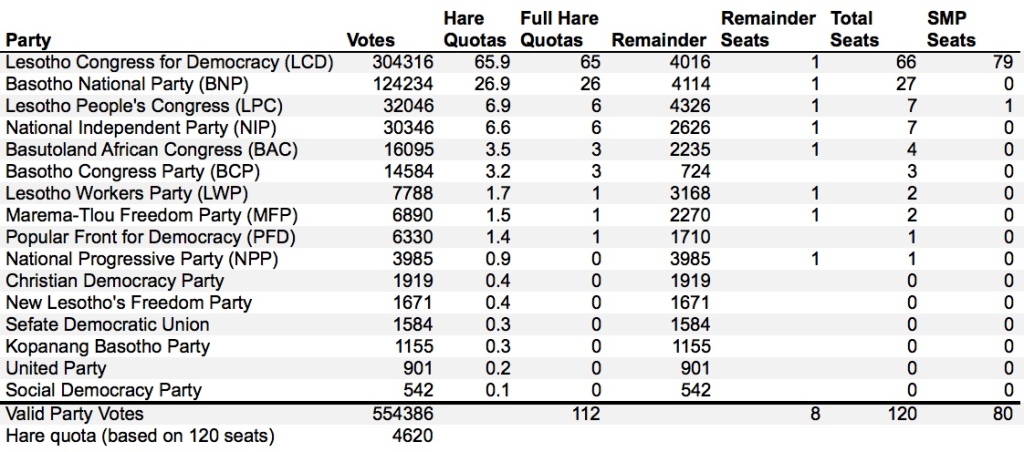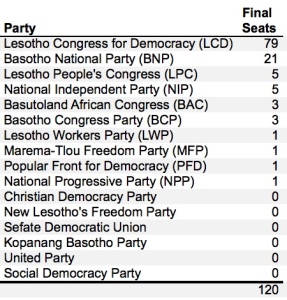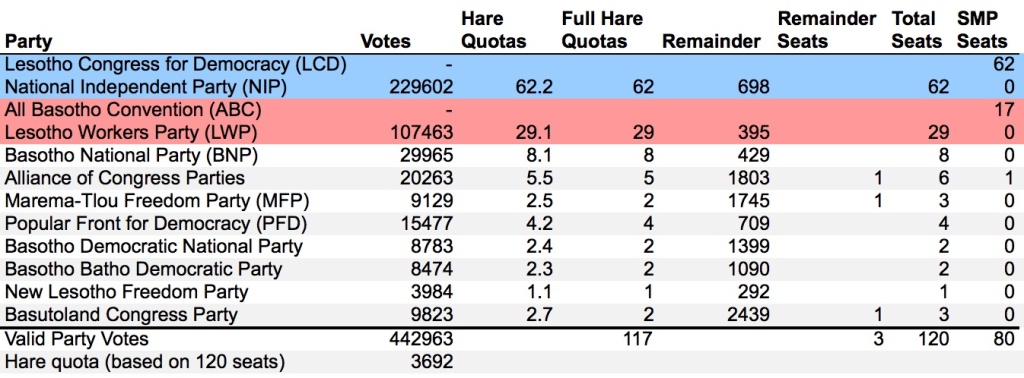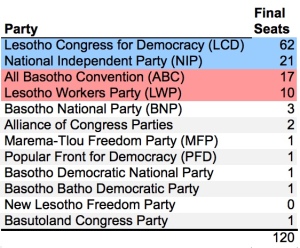The 80 members of the first Basutoland National Council were elected indirectly or appointed in 1960. Direct elections were held for 162 District Council members who then indirectly elected 40 members of the National Council. An additional 40 members were appointed–14 by the Paramount Chief (who later became King Moshoeshoe II), 22 other principal and ward chiefs, and 4 senior government officials. Source: African Elections Database.
1965 Basutoland Delimitation Commission Report
LESOTHO 1 (1965)
In 1965, Basutoland elected a 60-member legislature that became the National Assembly of the Parliament of Lesotho when Basutoland became the independent Kingdom of Lesotho. The legislature was elected by the single-member plurality electoral system.
1969 Report of the Constituency Delimitation Commission
LESOTHO 2 (1970-97)
Lesotho continued holding elections by the single-member plurality system after independence with the National Assembly continuing to have 60 members. The number of members increased to 65 in 1993 and 80 in 1997.
1985 Report of the Constituency Delimitation Commission
LESOTHO 3 (2002-7)
In 2002 and 2007, Lesotho utilized a mixed-member proportional (MMP) electoral system with two votes, one for a candidate in a single-member constituency and one for a closed party list. Among the 120 total seats, 80 were filled by the single-member plurality electoral system based on the candidate votes and 40 were top-up seats designed to render the overall allocation proportionate to the party vote.
The largest remainder system of proportional representation with a Hare quota was used to determine the preferred overall allocation of all 120 seats based on the party vote. The 40 top-up seats were allocated to bring each party up to the indicated total number of seats. Put another way, if the party vote indicated that a party should receive Y total seats but had already won X constituency seats (with X > 0), then it received Y – X top-up seats. Parties that won Y seats according to the party vote but had received no constituency seats just received Y seats. There was no legal threshold to qualify to receive mandates. Any top-up seats earned were allocated based on a closed party list.
The process was more complicated if a party had won more constituency mandates than the party vote indicated that it should hold overall (i.e. X > Y). These parties did not receive any top-up seats and the party votes were used again to determine a new proportionate allocation of seats. This recalculation excluded those votes and seats won by the party (or parties) that won an excess of constituency mandates as well as the votes of those parties that did not gain any seats according to the original allocation. The process might have needed to be repeated if other parties gained constituency mandates in excess of this new allocation.
The following table shows the initial allocation of mandates in 2002 based on the party votes utilizing the largest remainder system with a Hare quota. As the final column reveals, the Lesotho Congress for Democracy (LCD) won 79 single-member plurality (SMP) seats—more than 66 seats merited according to the party vote.
 As a result, the LCD received 79 seats and a second allocation was conducted of the remaining 41 seats based on the party votes of the parties other than the LCD that qualified for at least one seat in the first allocation:
As a result, the LCD received 79 seats and a second allocation was conducted of the remaining 41 seats based on the party votes of the parties other than the LCD that qualified for at least one seat in the first allocation:
 The next table shows the final allocation of seats by party in 2002:
The next table shows the final allocation of seats by party in 2002:
 In 2007, the two leading parties subverted the proportional intent of the MMP system by failing to file PR lists for top-up seats and encouraging their supporters to cast their party vote for a different party that ran no candidates in the single-member constituencies. As a result, smaller parties received fewer seats than they otherwise would have gained if the two parties had run PR lists. Here is the initial attempt to allocate the 40 top-up seats in 2007 along with the results from the constituency elections in the last column:
In 2007, the two leading parties subverted the proportional intent of the MMP system by failing to file PR lists for top-up seats and encouraging their supporters to cast their party vote for a different party that ran no candidates in the single-member constituencies. As a result, smaller parties received fewer seats than they otherwise would have gained if the two parties had run PR lists. Here is the initial attempt to allocate the 40 top-up seats in 2007 along with the results from the constituency elections in the last column:  The Lesotho Congress for Democracy (LCD) won 62 constituency mandates and the All Basotho Convention (ABC) won 17 mandates. But neither filed party lists, so neither received party votes or was entitled to any seats according to the overall allocation. Instead, they encouraged their supporters to cast their party votes for their partners–the National Independent Party (NIP) for the LCD and the Lesotho Workers Party (LWP) for the ABC. These separate parties won no constituency seats and did not have the seats won by the LCD or ABC from their seat entitlement.
The Lesotho Congress for Democracy (LCD) won 62 constituency mandates and the All Basotho Convention (ABC) won 17 mandates. But neither filed party lists, so neither received party votes or was entitled to any seats according to the overall allocation. Instead, they encouraged their supporters to cast their party votes for their partners–the National Independent Party (NIP) for the LCD and the Lesotho Workers Party (LWP) for the ABC. These separate parties won no constituency seats and did not have the seats won by the LCD or ABC from their seat entitlement.
The LCD and ABC constituency victories rendered it impossible to award other parties their full entitlement based on the party vote. A second allocation was conducted based on the party votes but excluding the 79 seats won by the LCD and ABC:
 This manipulation of the electoral system allowed the LCD and NIP to win more seats together than they would have gained as a single party to the detriment of smaller parties. Here is the final seat allocation from 2007:
This manipulation of the electoral system allowed the LCD and NIP to win more seats together than they would have gained as a single party to the detriment of smaller parties. Here is the final seat allocation from 2007:
 LESOTHO 4 (2012-)
LESOTHO 4 (2012-)
In order to avoid a repeat of the manipulation of the electoral system in 2007, Lesotho tweaked its MMP electoral system so that voters cast a single vote instead of separating constituency and party votes. This single vote determines the outcome in constituency elections as well as the allocation of top-up party list mandates. Unlike in 2002 and 2007, a single allocation sufficed to determine the distribution of the 40 top-up seats in 2012.
